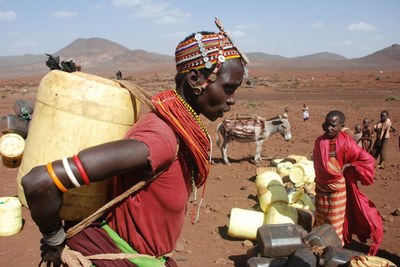East Africa Famine: New challenges in northern Kenya

Marsabit, North Kenya, is the most famine-affected areas in the country. Millions are facing hunger and an uncertain future, after the drought destroyed their crops and livestock. Although recent heavy rain has brought an end to five years of drought, new challenges have emerged which SOS Children are overcoming to reach those most in need.
Following recent heavy rains in Marsabit, green shoots have begun to emerge from the muddy ground. “Camels returning to the lowlands indicate that pastures are becoming greener,” says Joseph Kajwang, manager of SOS Children’s Family Strengthening Programme in the area. Yet there are problems anticipated ahead. There are concerns about families sowing their scarce supply of seeds outside of the traditional planting season, which, in this region, does not begin until April. Joseph also recognises the scarce supply of livestock in the area. “What is clearly missing from the landscape around north Kenya is the livestock that have died of thirst over the past five years” he says “this has been compounded by the recent loss of cattle and goats that have succumbed to pneumonia as a result of the colder and wetter conditions”.
Since the immediate onset of famine, SOS Children have been addressing the needs of families in the area by providing food distribution through local schools. However, recent problems have affected the programme. Unimix, a porridge enriched with high-protein maize given to malnourished children, was recently withdrawn from all five schools in the SOS School Feeding Programme, after samples of the product elsewhere in Kenya were found to contain potentially dangerous alfatoxins. None of the children in the SOS programme have been affected and alternative food supplies have now been sourced.
The transportation of certified hybrid maize and bean seeds is also causing problems. Trucks are frequently becoming stuck in the muddied road that links Marsabit to the capital Nairobi 600km away, adding to already inflated costs.
SOS Children continue to help families
In spite of massive inflation that has contributed to a 15 per cent rise in the cost of maize over a two month period, SOS Children’s School Feeding Programme has continued to provide 9,000 individual meals every week since August. The programme has both given children a healthy diet, and allowed them to continue their education.
“We have full attendance in almost all classes and there have been a few new enrolments, which can be attributed to the availability of food supplied by SOS Children” says the principal of the SKM Primary School in Marsabit, northern Kenya. Mr Kirbo says he has noticed “a definite change in the children since we started providing them with school meals”
In addition, almost 2,000 drought-affected families continue to receive food and provisions from local shops through the use of the unique SOS Children’s Smart Card system.
How you can help
You can make a one-off donation directly to our Emergency Relief Programme, or take out a child sponsorship to help us to focus on the long-term welfare of children who have no one to care for them as a result of the famine.

 Return to Schools Wikipedia Home page…
Return to Schools Wikipedia Home page…
